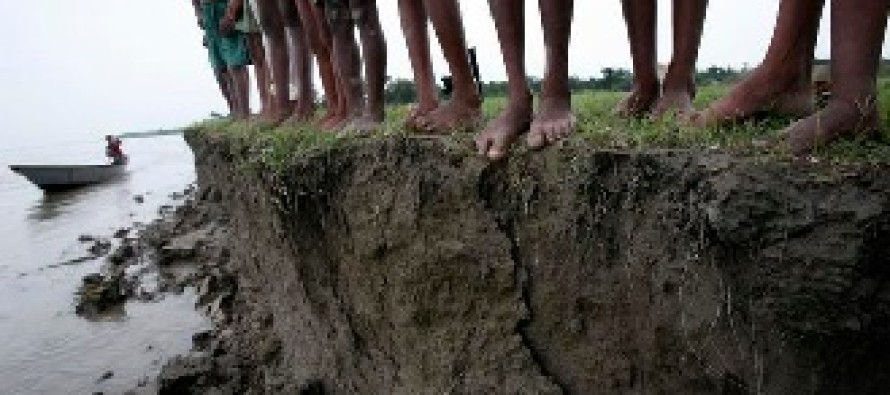Land erosion by rivers brings miseries to millions of people

Rivers are the life-blood of Bangladesh. In fact Bangladesh’s land territory owes to its physical existence to rivers, that carried billions of silt for million of years from the Himalayas. Thus the land formed was known as Banga, Bengal, East Pakistan and Bangladesh.
Rivers are boon to the people of the country, and at the same time, they create havoc to normal life of people. This is a paradox that Bangladesh people have to live with. That means nature can be kind and cruel at the same time.
Statistics show that between 250 and 270 rivers flow through Bangladesh and its combined length is about 24,140 kilometres. Out of these, about 12,000 are vulnerable to soil erosion by flow of rivers during monsoon season.
Between 1986 and 1990, it has been reported that out of 464 Upazillas, lands of 210 Upazillas were subject to river erosion. Of the most vulnerable to erosion by rivers are 15 districts. They are Munshiganj, Sirajganj, Pabna, Manikganj, Chandpur, Tangail, Jamalpur, Gaibandha, Kurigram, Rangpur, Chapaiganj, Faridpur, , Barisal, Bhola, and Chittagong.
Padma, Meghna, Jamuna, Kushiara, Teesta, Khowai , Surma, Sangu, Manu, and Gomati rivers are the ones that cause heavy erosion of lands, in particular during monsoon season. It is reported that miles and miles are devoured by rivers. Owners witness helplessly their homestead and farming lands are being lost by the current of rivers. In the past the whole Noakhali town was lost to rivers and the headquarters was shifted to inland, Maijdee town.
Experts believe that soil erosion is due to many factors, such as, change of course of rivers, sudden speed of monsoon waters after heavy rainfall, deposits of silt on river-bed, and loss of river bed.
However some human activities also cause erosion of lands. Barrage, Dykes, Dams and other structures on rivers impede the natural flow and direction of rivers. They change the normal flow of rivers and have an impact on banks which gradually are lost to rivers.
After independence f Bangladesh, it is reported that 45 lakh (4.5 million) people have lost their homes and lands. At the same time, 2,000 square kilometers have been devoured by rivers. It is estimated that per year between 2 and 3 lakh ( two to three hundred thousand) people are displaced by river erosion. Economists say that national wealth of to the amount of Taka 1,000 crore is being lost per year.
During the last five years, it is reported that more than 26 lakh people have been become landless and displaced from their lands and 5 lakh 50 thousand acre lands were lost in the rivers.
These displaced persons have nowhere to go and eventually they come to cities and live in slums. Most of them have no assets, are poor, unemployed and young people among them create or responsible for social ills. Women are vulnerable to exploitation and so also are the children. Human trafficking takes place with women and children. Sale of drug and small fire-arms is rampant in slums. Many young males of the slums join criminal gangs.
Despite the natural and man-made disaster and sufferings of people, in 1993 the government has recognized it as a “disaster”. However until now, there is no available reliable statistics of displaced persons in the country due to river erosion with any agency of the government.
Another fact is that the landless people do not have any right or priority of claim on chars (small islands) if they are formed on the river or on newly formed lands on the other side of rivers. The accretion of lands or chars becomes Khas (government) lands under the existing law. Ordinarily empirical evidence suggests that these lands are allotted to influential people.
As a result, poor people are deprived of the newly-formed lands because they have no voice in the community. In fact one may argue that these lands are “recycled” by rivers from the lands of poor people, devoured by rivers. Many suggest that the law should be changed so that people who lose lands due to river erosion should have a priority of claim to get these new lands from the government.
The issue has assumed urgency because it is reported that 56% per cent of the total population in the country are landless and the number will increase every year because of river erosion.
The landless people, if deprived and poor, may be exploited by some people who like to foment trouble in the country. Threat to stability and security does not only emanate from external sources but also may arise from internal situation. For example, threat to Nepal’s political and economic stability did not come from outside powers but from Maoists rebels who are home grown and Nepalese themselves.
All people must have four freedoms: freedom from want, freedom from fear, freedom of speech and freedom of religion. It is the responsibility of governments to ensure these basic rights of all the people in the country, otherwise instability may set in.
By Barrister Harun ur Rashid
Former Bangladesh Ambassador to the UN, Geneva.


